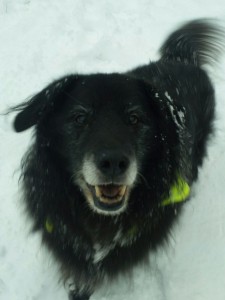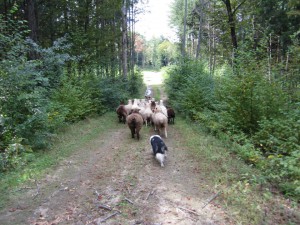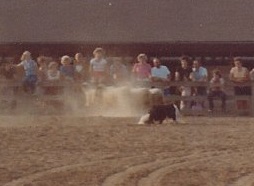How often have I heard “He has a mind of his own” accompanied by a huge sigh or the gritting of teeth? Or “She’s so stupid. She doesn’t do what I want her to do.” Inevitably, I see before me a dog who is way smarter than his owner recognizes, who isn’t engaged in a battle of wills with his owner but has decided, lacking better information or something interesting to do, it is up to him to figure out the world. The dog who figures out how to get into the food cabinet, the dog who catches the rabbit, the dog who fearlessly follows the deer scent into the next county, the dog who pushes all the ducks at the local pond into a corner, the dog who digs under the porch where the mice are living: All “have a mind of their own”. Aren’t they all exercising abilities on which we humans have relied for centuries? Aren’t they all using their brains to do amazing things that we can’t? Well, I hope we can all get into the food cabinet… but you know what I mean. I am sure many of my dog training colleagues recognize the scene.
When I was 11 (1971), I saw my first sheep herding demonstration at the Timonium State Fair. The Border Collie looked strikingly like our family dog, who at various times in his life had attempted to exercise his inner border collie by herding the neighbor’s cattle but was mostly content to watch over his three charges, my brothers and me. In retrospect (now that I have 3 border collies, 27 sheep, 7 goats…and a llama) it was a life changing moment. I can still put my hands on the horrible instamatic photos where the dog is barely a speck in the distance. It is one of the few stand out memories of my childhood. And I remember my mother being just about as excited as I was. I couldn’t articulate it then, but what struck me was not the athleticism of the dog but the self control, focus on his job and his partnership with his handler. I recognized that the dog wasn’t just a remote control device strategically placed by the human but an active thinking participant in the task: a dog fully utilizing his mind.
The dogs I had growing up and in early adulthood had “brainiac” written on their faces. It might be that they all had herding breed in their heritage – dogs that because of their breeding for a job that requires close partnership with humans were better at reading me than some dogs. So they had that sort of intelligence that we self-centered humans easily recognize. I had a lot to learn about the intelligence of other breeds. Then in 2003 we got a mutt, Magic, from the shelter. He was a nice enough dog. I know I uttered the words “He isn’t the brightest bulb on the block. And he is hard headed and doesn’t listen to me”… Boy was I wrong. I just didn’t yet appreciate that he could read other dogs in a way that I still can’t, despite 10 years of tutelage from him. Or that he, like a “real” dog, could actually catch a bunny. Or that he could read my facial expressions. Or that at most dog seminars, even at 9 or 10 years old, he would be the last dog standing, still ready to work and learn something new when three year old dogs lay exhausted in their crates, brains fried. I was the low wattage bulb. Not he.
 Before I knew these things about him, I took him to an agility class that I had started with a foster dog who was adopted out from under me. I had paid for the class, I might as well take the remaining four sessions, though I was doubtful much would come of it. And what happened next was magical. He lit up and he loved every second of learning the new things. We did agility just for fun for many years. I started to use him for dog-dog evaluations for a border collie rescue because he was just generally calm around other dogs. All I wanted was a neutral dog to see how the evaluated dog reacted. I quickly came to realize that I could watch him and know what was going on with the other dog. He was consistently right and interacted in ways that often calmed adolescent goofballs. But he also instantly knew when another dog was trouble. A brilliant mind.
Before I knew these things about him, I took him to an agility class that I had started with a foster dog who was adopted out from under me. I had paid for the class, I might as well take the remaining four sessions, though I was doubtful much would come of it. And what happened next was magical. He lit up and he loved every second of learning the new things. We did agility just for fun for many years. I started to use him for dog-dog evaluations for a border collie rescue because he was just generally calm around other dogs. All I wanted was a neutral dog to see how the evaluated dog reacted. I quickly came to realize that I could watch him and know what was going on with the other dog. He was consistently right and interacted in ways that often calmed adolescent goofballs. But he also instantly knew when another dog was trouble. A brilliant mind.
The journey I took with him paralleled my work as a volunteer dog walker in a Pittsburgh city shelter. Everyone was focused on getting the dogs, cooped up in kennels all day, out for exercise. They would throw a tennis ball for a lab for hours and the lab would go back to the kennel just as stressed as when they started. Thanks to the burgeoning shelter enrichment movement, I very quickly realized that physical exercise was only a small piece of what the dogs needed. Often they needed three other things: to learn how to exercise self-control and self-calming, to open communications lines with humans and to use their brains. It was hard for many volunteers to see at first, but every time those things were put in place, the dogs were able to manage their sterile and stressful kennel existence much better. And they became better adoption prospects. Because I worked with every breed and mix, I came to see that every dog has her own sort of smarts, often exactly what we bred her for. Hmm, all those pet dogs with “minds of their own”… Perhaps they just have the minds we bred them for.
In 2006 I took my fear aggressive border collie for a sheep herding lesson. I couldn’t do classes with him – too stimulating and scary. Much of his life was constrained by his fears and I was looking for that something that would grab his attention. The moment he turned onto sheep, there was probably no turning back for *me*. Though it turned out his fears, his aggressive responses and my mistakes handling those issues, made him an unsuccessful sheep dog, he had a lot of natural talent. Watching him read the sheep better than I could was a sight to behold. He “knew” what I am still learning. Watching him, started me on a journey of thinking about human working relationships with dogs. My dog trainer friends in 2006-8 or so were bored with my long missives about self-actualized behavior and my lingering doubts about much of the training around me. It seemed to entail disengaging much of the dog’s brain to achieve robot like obedience. Even positive reinforcement training can turn a dog into a robot if you don’t appreciate the mind within the animal.
Fast forward to yesterday. My brother does dressage with horses. I was describing to my brother, how Jura, my herding dog, is really thinking for himself now that he is three. He has natural talent on stock, what they call in the biz “stock sense”. He can read the sheep and situates himself in such a way that he covers the problem – often as, or before, I see it coming. For example, when moving the stock back to the barn, there is a yummy patch of clover to the right. He naturally puts himself between the sheep and the clover while still moving them forward. Usually if I issue a command to do it, I don’t put him in quite the right place and it looks much messier. He listens, but I am sure he sometimes wonders how I can be so sloppy. He also knows exactly where to stop when he has driven the sheep to the
 barnyard gate. They are comfortably held to the gate until I get up to open it. He has learned from experience the sweet spot and I no longer even need to ask him to stop. Every day something comes up where Jura has to think for himself. Sheep have minds of their own and he will always be better at noticing their intentions than I am. I can send him out on a blind gather – where I can not see the sheep. And he does all the things he needs to do, on his own, to bring them back to me.
barnyard gate. They are comfortably held to the gate until I get up to open it. He has learned from experience the sweet spot and I no longer even need to ask him to stop. Every day something comes up where Jura has to think for himself. Sheep have minds of their own and he will always be better at noticing their intentions than I am. I can send him out on a blind gather – where I can not see the sheep. And he does all the things he needs to do, on his own, to bring them back to me.
So, there I was rejoicing in the wonder of my dog thinking for himself. Almost everyday he amazes me with something. And my brother laughed. His horse thinks for himself, often to a dressage trainer’s dismay. If he is to get the horse through the dressage tests, the horse must NOT think for itself.
Given my personality type, Dressage and Competition Obedience to me are mystifying. In my most cynical moments I think, “I could go get one of my husband’s robots if I wanted something to do exactly and precisely what I want it to do”. I realize that there is much more to the sports than that, but I also see people who exercise a level of control in those sports that is soul sucking and mind numbing, definitely for the dog, and likely, though less recognized, for the human. I have often heard the lament “my dog seems bored with training”. Well, yes! Doing the same seemingly meaningless (to the dog) thing over and over is boring. Learning something new might be more interesting. No dog has ever asked to do sits and downs and walk in precise formation around a course UNLESS the handler and dog have such a good relationship that doing the activity is about the relationship – not the activity itself. Far too often I see dogs that are doing what they are told to do without enthusiasm and a handler that is completely oblivious to the dog’s state of mind. They are happy that their dog is obeying them. And it barely occurs to them that perhaps their dog is “bored”. I am pretty sure the typical tracking dog, herding dog, hunting dog would consider doing her preferred activity on her own but show me the video of an obedience dog doing his routine on his own.
Agility – which relies mostly on the dog’s athleticism and not on thinking for himself – can also be mind numbing for the dog in the wrong circumstances (though plenty of dogs like to make up their own agility courses). Sometimes I see agility dogs who are nervy and unhappy because, while their physical needs are being well met, those brains are going to waste. They are a bundle of nervous energy – not because they need a physical outlet but because, like the shelter dogs that would play fetch for hours and still not de-stress, they need to use those brains. And I have seen people dip into herding with their dogs, trying to exercise the same level of control over their dog that they do in obedience, often squelching some of the dog’s natural ability. It is probably true that humans have the capacity to make almost any activity mind numbing so I probably shouldn’t pick on Obedience and Dressage.
Now, some of my dog trainer friends are probably feeling their hackles rise. There are a whole lot of good reasons to participate in these activities. In the hands of a handler who understands their dog’s needs, all of these activities can enhance the dog’s life. They provide an outlet for the athletic dog. They can be relationship building. They can improve communication. They can be fun for both the dog and the human with the right attitude. Achieving precision in a partnership can be fun. Don’t get me wrong. I have had agility runs bring tears to my eyes when dog and human are in sync. But rarely are we taxing our dog’s brain except in the earliest stages of learning the behaviors. So you will never catch me saying “Don’t participate” if you and your dog are having fun, but always think about what else you are doing to appreciate and exercise your dog’s amazing mind. The best handlers I know give their dogs many other things that exercise their brains.
Most of us have have gotten very far away from the tasks that drew humans into working relationships with dogs – hunting, herding, vermin extermination, guarding – and it is so easy for us to look at our dogs and not fully appreciate that they have “minds of their own”. After all, most of them are cuddly looking, astonishingly adaptable, often at great cost to themselves. As dogs became pets and companions and fellow competitors in things that, let’s face it, really only we humans care about, we have dumbed down their jobs. They are no less amazing, just because we can’t see it or find ways to utilize their smarts in our everyday lives. One of the things I love about the “nosework” movement is that it shows owners just how much their dogs know that they can’t.
When I have an owner complain that their dog “has a mind of its own” or that the dog is “stupid”, I try to suppress the smirking grin that begins to emerge on my face. To me it is an irresistible challenge to help the dog show his people just how smart he is and just how wonderful it can be to live with an animal that “has a mind of its own”. I have never had a dog disappoint me yet. They are all willing partners in this endeavor to train their humans. Sometimes we have to teach the human to talk dog. Most dogs are darn good trainers of their people, once someone opens the door enough to give their people the tools to understand. Often they have already trained their people well, only the people don’t realize it.
Meanwhile back on the farm, I thank dog for the fact that Jura has “a mind of his own”. My life would be so much harder if he didn’t.

